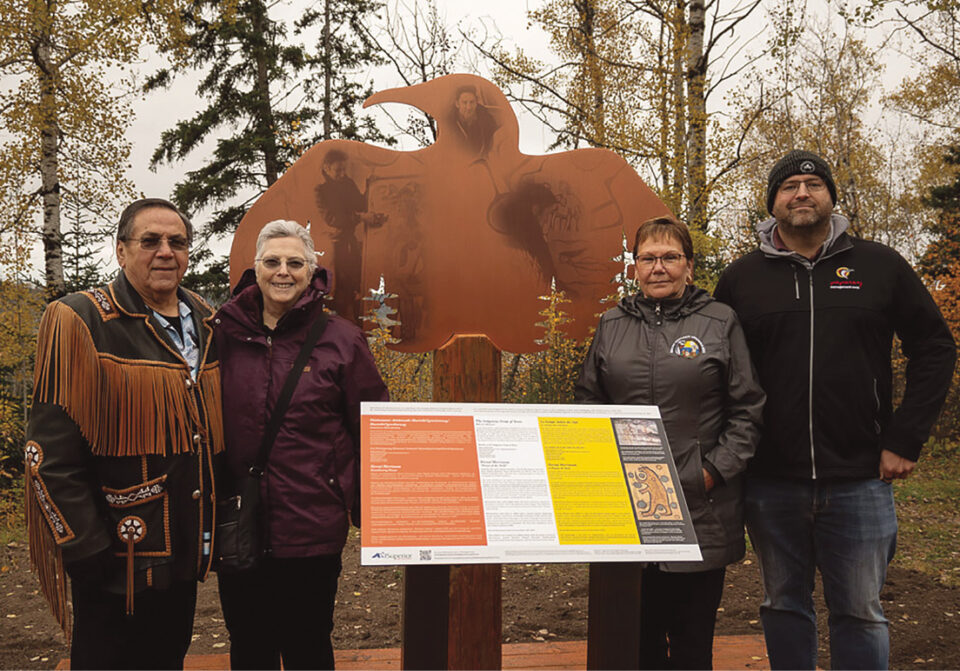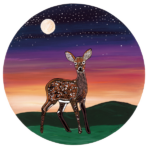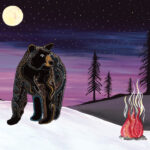A modern-day ‘historic’ event took place in Nipigon, Ontario, in October of this year. An impressive monument was officially unveiled at Nipigon’s Bridgeview Lookout Tower, overlooking the Nipigon River. But this wasn’t an ordinary kind of monument. It was honouring the Indigenous Group of Seven and one of its famous members, the Indigenous artist Norval Morrisseau—who was born and spent his early years in the area.
Topping the monument is a large metal bird—Copper Thunderbird—with airbrushed images of Morrisseau and his artwork. Directly below is an interpretative panel written in Ojibwe, English, and French, which celebrates Morrisseau and the other six artists of the Indigenous Group of Seven. Morrisseau’s spirit name is Ozaawaabio-binesi, which in Cree means “Copper Thunderbird.”
Attending the installation ceremony was Eugene Morrisseau, one of Morrisseau’s seven children. “It makes me proud. It’s a great honour for my father because he was born there—that’s his traditional area,” said Eugene.
The monument is part of the Lake Superior Tourism Project and was developed in collaboration with the staff of Superior Country, Norval Morriseau’s estate; Joseph Sanchez (a member of Indigenous Group of Seven); Bingwi Neyaashi Anishinaabe First Nation, and the Red Rock Indian Band. Designed by Firedog Communications, it was fabricated and installed by BHP Productions (both Thunder Bay companies).
So, who are the Indigenous Group of Seven? Besides Morrisseau, the professional artists include Jackson Beardy, Eddy Cobbines, Alex Janvier, Daphne Odjig, Carl Ray, and Joseph Sanchez. Beginning as a trail-blazing collective in the early 1970s, they had a goal to have their work included as art and not labelled “Indigenous craft.” Their group name—Indigenous Group of Seven—was influenced by the other Group of Seven formed by Euro-Canadian artists in the 1920s and famous for their paintings of the Canadian wilderness.
In a 2018 interview, Sanchez told CBC’s Radio Active, “Native art was always just considered craft and not considered fine art. We’re very committed to the community and to bringing contemporary Native art into the mainstream of Canada and the world in general.”
And the Indigenous Group of Seven were successful in their goal. Here’s a snapshot look at the seven Indigenous artists, listed in alphabetical order.
- Jackson Beardy (1944-1984) was an Ojibway born on the Garden Hills Reserve at Island Lake, Manitoba. He was a residential school survivor, studied at Winnipeg’s University of Manitoba, and was a “pioneer in expressing the new iconography of his people by reconceptualizing Indigenous symbolism” (Memorable Manitobans).
- An Ojibway born in Warroad, MN, Eddy Cobbines (1933-1996) was raised on Manitoba’s Buffalo Point Reserve. While in the U.S. Army, he developed his artistic skills during leisure time. His art, which has been described as “gentle flowing lines,” helped to define contemporary Native Canadian art.
- World-renowned Alex Janvier (of Dene and Saulteaux descent) was born in 1935 at Cold Lake, Alberta, and attended residential school where the principal encouraged his artistic side. A pioneer in Indigenous art in Canada and who still paints today, Janvier is a graduate of Alberta’s College of Art in Calgary. On his website is a description stating, “His vibrant colours and distinctive lines tell you stories about his unique culture and life experience.”
- Sometimes referred to as “Picasso of the North,” the worldwide highly acclaimed Norval Morrisseau (1932-2007) was a self-taught Ojibway artist born and raised along the southeast shores of Lake Nipigon on the Bingwi Neyaashi Anishinaabe First Nation (formerly known as Sand Point First Nation). Morrisseau’s artwork evolved into bold vibrant colours outlined in black lines of people and animals with a connection to Indigenous traditions and stories. He was the founder of the Woodland School of Art.
- Daphne Odjig (1919-2016) was an Odawa-Potawatomi internationally recognized visual artist who was born and raised on the Wiikwemkoong Unceded Indian Reserve on Ontario’s Manitoulin Island. Her decades of artwork featured lyrical legend paintings, and she was the first First Nation woman to have an exhibit at the National Gallery of Canada (2009). She was the recipient of many awards, including Canada’s Governor General’s Award in Visual and Media Arts (2007).
- Mostly a self-taught Cree artist, Carl Ray (1943-1978) was born on Sandy Lake First Nation in Northwestern Ontario and painted in the style of the Woodland School (also known as “legend painting”), mentored by Morrisseau. In describing his work, he said, “What you are looking at is ancient and sacred. In fact, what you see could be part of my soul.”
- The only non-Canadian in the group is artist and curator Joseph Sanchez, born in 1948 in Trinidad, CO. Of Pueblo, Spanish, and German heritage, Sanchez was in the U.S. Marine Corps before moving to Canada and later returned to live in the U.S. During his career, he was deputy director and chief curator at Maine’s Museum of Contemporary Native Arts (2002-2011) and later contemporary curator of the Native American Art at New Hampshire’s Dartmouth University.
The ground-breaking Indigenous Group of Seven brought professional recognition and respect throughout the world for Indigenous artists and their artwork.





